Thursday – Croft – Bright sunshine pours down on the field as Maddy and I head up towards the woods. The distant hills are hardly visible in the heat haze and mist. From the top of the field containing the old Spanish Chestnuts, which are now in full leaf although that may only be a few twigs-worth in the case of the most far gone specimens, a track leads westwards along the southern edge of Ladyacre Plantation. It is delightfully 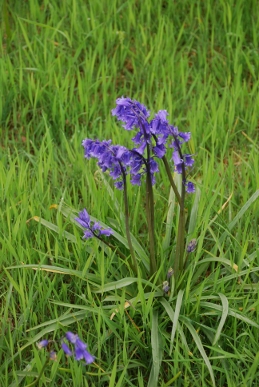 cool here as the track is shaded by an open hedge of mainly Hawthorn with the occasional Beech and Elder. The last of the Bluebells, although there are still many in flower, mingle with Red Campion and in the wood itself, with the white stars of Stitchwort. Bracken fronds are almost entirely unfurled. The trees along the edge of the woods are, I think, Hemlock Spruces. They have branches ending in emerald new-growth and stubby little cones. The track suddenly turns south-west but I keep on westwards on a smaller path which then turns north. It passes a large Sweet Chestnut with a variety of insects on its leaves, soaking up the sun. Flies, a brown dragonfly that flits away immediately and Speckled Wood butterflies which dash up into the air and flit together before descending again. Another path heads off west again and then south-west. In the shade there are numerous small day-flying moths, mainly a small spotted yellow one which I think is a Speckled Yellow. This path joins a track which is part of the Mortimer Trail. We head northwards. A pair of Fallow Deer look anxiously down the track before vanishing off westwards into a plantation of young Spruce. Maddy starts to follow but after a couple of commands returns to her ball – I
cool here as the track is shaded by an open hedge of mainly Hawthorn with the occasional Beech and Elder. The last of the Bluebells, although there are still many in flower, mingle with Red Campion and in the wood itself, with the white stars of Stitchwort. Bracken fronds are almost entirely unfurled. The trees along the edge of the woods are, I think, Hemlock Spruces. They have branches ending in emerald new-growth and stubby little cones. The track suddenly turns south-west but I keep on westwards on a smaller path which then turns north. It passes a large Sweet Chestnut with a variety of insects on its leaves, soaking up the sun. Flies, a brown dragonfly that flits away immediately and Speckled Wood butterflies which dash up into the air and flit together before descending again. Another path heads off west again and then south-west. In the shade there are numerous small day-flying moths, mainly a small spotted yellow one which I think is a Speckled Yellow. This path joins a track which is part of the Mortimer Trail. We head northwards. A pair of Fallow Deer look anxiously down the track before vanishing off westwards into a plantation of young Spruce. Maddy starts to follow but after a couple of commands returns to her ball – I 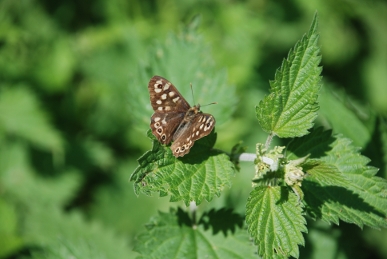 can do without her chasing off and getting lost! Willow Warblers call from the trees. There is hardly any indication when the Mortimer Trail leaves the track and heads in parallel along a grassy avenue. It then emerges onto the top of Yatton Common. Views extend northwards across Yatton Marsh, now drained and divided into pasture, and on towards Wigmore. Westwards is the conical, tree-covered hill of Pyon Wood, hiding an Iron Age hillfort. Beyond are wooded hills and valleys often containing a farmhouse. To the north-east is the top of Croft Ambrey. The common is covered in Bracken and speckled blue with Bluebells. The path heads towards Croft Ambrey along the northern edge of Ladyacre Plantation. As I sit and look out over the view below a couple pass and tell me they have covered some 18 miles of the trail in the past two days and I am the first person they have met! Past a clump of small trees from which comes a scratching and bubbling song. I am convinced it is Garden Warbler which seems confirmed by the impossibility of finding the songster. Eventually a small plain brown bird moves off to another clump of trees and the songs emerges from there, pretty much confirming its identity. We take the track down from Croft Ambrey back to Croft Castle. The dead tree which was covered in red silk last year now stands coloured a delicate pink where the silk has weathered. Below it, Swallows flash across the grass collecting insects for their growing broods.
can do without her chasing off and getting lost! Willow Warblers call from the trees. There is hardly any indication when the Mortimer Trail leaves the track and heads in parallel along a grassy avenue. It then emerges onto the top of Yatton Common. Views extend northwards across Yatton Marsh, now drained and divided into pasture, and on towards Wigmore. Westwards is the conical, tree-covered hill of Pyon Wood, hiding an Iron Age hillfort. Beyond are wooded hills and valleys often containing a farmhouse. To the north-east is the top of Croft Ambrey. The common is covered in Bracken and speckled blue with Bluebells. The path heads towards Croft Ambrey along the northern edge of Ladyacre Plantation. As I sit and look out over the view below a couple pass and tell me they have covered some 18 miles of the trail in the past two days and I am the first person they have met! Past a clump of small trees from which comes a scratching and bubbling song. I am convinced it is Garden Warbler which seems confirmed by the impossibility of finding the songster. Eventually a small plain brown bird moves off to another clump of trees and the songs emerges from there, pretty much confirming its identity. We take the track down from Croft Ambrey back to Croft Castle. The dead tree which was covered in red silk last year now stands coloured a delicate pink where the silk has weathered. Below it, Swallows flash across the grass collecting insects for their growing broods.
Tuesday – Leominster – Finally, it rained last night – seriously rained! The garden has been parched by the continuous hot, dry weather and the little rain we have had has barely damped the surface. But now the garden has been soaked and the first water-butt is full again. As the Hawthorn flowers fade away Elderflowers come into bloom. I gathered enough from Ryelands and the area behind the Minster to make some champagne and cordial. Today it is down to the river and millennium wood. Along the rough pasture to the west of the River Lugg where there are some Elders in blossom, but they have a painful protector – deep beds of nettles, Goosegrass (Cleavers) and thistles. After getting stung and pricked I find the creamy heads of flowers are too high anyway. Fortunately, further down there are a few, more accessible flowers. A bright Small Copper butterfly is resting on a nettle; damselflies with dark brown or black wings flit over the meadow. They are Agrion virgo species, the browner winged being younger individuals. Over the river and into the wood, which is all saplings, mainly of Guelder-Rose, a pretty but fairly useless tree. There are few Elders here. The weather is close and humid. Insects buzz around me annoyingly. I have enough Elderflowers to make another batch of cordial so its back home.
Friday – Mortimer Forest – All is green. The fir trees have bright emerald new-growth at their tips. The deciduous trees are all now in full leaf. The orange-brown carpet pile of needles covering the ground is being hidden under green ferns and Bracken. A Chiffchaff is still singing non-stop from the top of a Larch. A Common Buzzard mews in the distance and likewise there is a background rasp of Rooks. Blue Tits and Great Tits squeak occasionally, but concentrate on insect gathering for their broods. Foxgloves are coming into flower. Maddy had decided that a good way to cool down is to lay out in a wheel rut filled with muddy water!
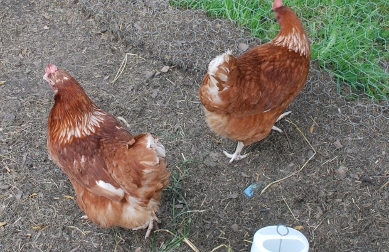
Saturday – Home – Freckles the hen has been laying soft-shelled eggs for some time now and appears from the literature that hens seldom return to laying hard-shelled eggs, so she is despatched. I hate killing things but one has to be realistic, the hens are being kept for eggs and their upkeep costs money. So, off to Dinmore to see what they have in terms of point-of-lays. There are some lovely 28 week old hens. They look like Warrens with white tips to their nape feather. I buy two and bring them home. A fence is put across the run and the new girls (already named Warren and Beaky by Kay) are introduced. Jaq, the Light Sussex cross, immediately crashes through the fence and viciously attacks the new hens. I separate them again and they settle down. Jaq attacks whenever she can and it looks like it will take a while before there will be a peaceful co-existence.
Tuesday – Mortimer Forest – Leominster Civic Society hosted an inspiring talk last night by Archie Miles, an author specialising in British trees. A good number of local trees were mentioned but it was a comment from a member of the audience that I am following up this morning. The person asked whether a row of Oaks in the Mortimer Forest marked the Herefordshire-Shropshire border; the speaker did not know. From the main track a path leads down towards Black Pool. The path winds through 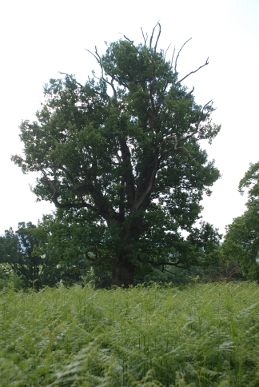 waist-high Bracken with a mixture of trees – Oaks, Beeches, Sycamores and Birches. Into thicker woods where there is a deep gulley to the north with a stream that feeds Black Pool at the bottom, near the Ludlow-Richards Castle-Leominster road. To the south of Black Pool there is an old sunken track and beside it is the row of Oaks. Although one has “stag horns” rising high above the canopy, the trees are probably less that 200 years old, so an old but not an
waist-high Bracken with a mixture of trees – Oaks, Beeches, Sycamores and Birches. Into thicker woods where there is a deep gulley to the north with a stream that feeds Black Pool at the bottom, near the Ludlow-Richards Castle-Leominster road. To the south of Black Pool there is an old sunken track and beside it is the row of Oaks. Although one has “stag horns” rising high above the canopy, the trees are probably less that 200 years old, so an old but not an 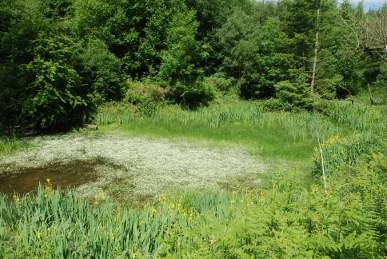 ancient line of markers. However, they may mark an old ride between Moor Park House to the Deer Park. A female Redstart stands in the Bracken repeating an alarm call. Back on the forest track a piece of limestone lays on the ground. It is full of fossil seashells. Round to the pools below the Deer Park, except there is little water in them, an indication of the lack of rain over the last couple of months. Instead there is a carpet of tiny white flowers surrounded by a wall of green spears topped by sunshine coloured Yellow Flags. Tiny scarlet strawberries peep out from the stony bank. A Whitethroat is doing his dance in the air whilst singing loudly. I head up the track, climbing steadily. Blackcaps sing hidden in the evergreen saplings. Across the long valley that runs north from the Deer Park is a sea of Larch saplings with a single great Oak rising above them. The track wanders south-easterly before turning sharply north-west towards the Mortimer Trail, but another track continues south-east and this is the one I follow. A Fallow Deer is grazing on a bend. It looks up, sees Maddy trotting down towards it and bounds off down the path and into the trees. The path stops at the edge of the field surrounding Haye Park House, but a barely discernible path (although clearly marked on the OS map) heads down the hillside through towering Larches back to the pools. The walk back to the car park seems long and hot. Maddy quenches her thirst in the numerous water-filled ruts in the track. A Raven grunts in the trees.
ancient line of markers. However, they may mark an old ride between Moor Park House to the Deer Park. A female Redstart stands in the Bracken repeating an alarm call. Back on the forest track a piece of limestone lays on the ground. It is full of fossil seashells. Round to the pools below the Deer Park, except there is little water in them, an indication of the lack of rain over the last couple of months. Instead there is a carpet of tiny white flowers surrounded by a wall of green spears topped by sunshine coloured Yellow Flags. Tiny scarlet strawberries peep out from the stony bank. A Whitethroat is doing his dance in the air whilst singing loudly. I head up the track, climbing steadily. Blackcaps sing hidden in the evergreen saplings. Across the long valley that runs north from the Deer Park is a sea of Larch saplings with a single great Oak rising above them. The track wanders south-easterly before turning sharply north-west towards the Mortimer Trail, but another track continues south-east and this is the one I follow. A Fallow Deer is grazing on a bend. It looks up, sees Maddy trotting down towards it and bounds off down the path and into the trees. The path stops at the edge of the field surrounding Haye Park House, but a barely discernible path (although clearly marked on the OS map) heads down the hillside through towering Larches back to the pools. The walk back to the car park seems long and hot. Maddy quenches her thirst in the numerous water-filled ruts in the track. A Raven grunts in the trees.
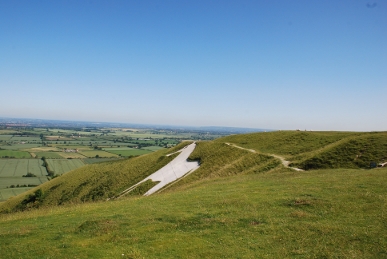
Thursday – Westbury – The small town of Westbury lies underneath the north-west edge of the huge chalk plateau of Salisbury Plain. To the east, on the scape slope is the Westbury White Horse. The current carving dates from 1778 which appears to have removed an earlier horse, which according to an engraving of 1760, faced the opposite direction. It is said that the horse’s origin was a celebration of King Alfred’s victory at the Battle of Eđandun in 878. However, there is no record of this legend before the mid-18th century and it is not even certain that the battle actually took place in this area. A lane climbs the hill from the village of Bratton to a car park which lies on the edge of the Iron Age hillfort of Bratton Camp. The camp has impressive double ramparts and ditches, enclosing an area of over 9 hectares (25 acres). Within there is a Bronze Age long barrow. The barrow was excavated in the 19th century when a number of burials were found. The camp itself was excavated in 1775 by 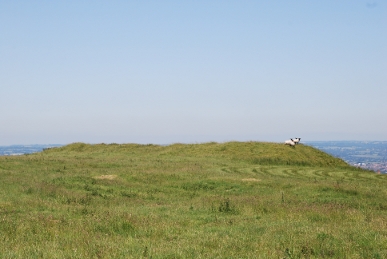 Jeffrey Whitaker, a local school master, who uncovered quern stones, pottery and Roman and Saxon coins. The excavations were poorly recorded and I am unclear whether there has been any subsequent work undertaken. The road into the site crosses the ramparts at the eastern end. It is a beautiful summer’s day. The view from the top of the escarpment across the Avon Vale goes on forever. In the foreground is a large cement works, now mothballed and it has been just announced that it will not reopen – a blow to local jobs. A Kestrel hovers over the escarpment. Sheep feed on top of the barrow as a tractor mows the rough downland grass. Skipper butterflies flit through the grass but are typically unhelpful in landing and taking off again before I can get a decent view of them. We wander southwards but are stopped by fences and warnings of firing ranges. The downs roll off into the distance – Warden Down, Thirteen Hundred Down, Knapp Down, Middle Ridge Down and Summer Down. A Sky Lark stands on a farm gatepost. A modern standing stone has been erected near the car park. It was erected to commemorate the Battle of Eđandun. The stone was unveiled by the 7th Marquess of Bath on 5th November 2000.
Jeffrey Whitaker, a local school master, who uncovered quern stones, pottery and Roman and Saxon coins. The excavations were poorly recorded and I am unclear whether there has been any subsequent work undertaken. The road into the site crosses the ramparts at the eastern end. It is a beautiful summer’s day. The view from the top of the escarpment across the Avon Vale goes on forever. In the foreground is a large cement works, now mothballed and it has been just announced that it will not reopen – a blow to local jobs. A Kestrel hovers over the escarpment. Sheep feed on top of the barrow as a tractor mows the rough downland grass. Skipper butterflies flit through the grass but are typically unhelpful in landing and taking off again before I can get a decent view of them. We wander southwards but are stopped by fences and warnings of firing ranges. The downs roll off into the distance – Warden Down, Thirteen Hundred Down, Knapp Down, Middle Ridge Down and Summer Down. A Sky Lark stands on a farm gatepost. A modern standing stone has been erected near the car park. It was erected to commemorate the Battle of Eđandun. The stone was unveiled by the 7th Marquess of Bath on 5th November 2000.  It is a sarsen stone similar to those at Kingston Deverill, the area where King Alfred rallied his Saxon levies from Hampshire, Wiltshire and Somerset to march against Guthrum’s Viking army based at Chippenham.
It is a sarsen stone similar to those at Kingston Deverill, the area where King Alfred rallied his Saxon levies from Hampshire, Wiltshire and Somerset to march against Guthrum’s Viking army based at Chippenham.
Heaven’s Gate – Into a delightful arboretum where Peter describes the air as “syrupy”. It is indeed very heavily scented by the pines and azaleas. One pine has a long scar down its trunk, not large or obvious but still a sign of a lightning strike. Through some gates and onto the edge of the hill where there are some large modern stone sculptures including a huge circle – Heaven’s Gate. Below is Longleat – the house laying amidst considerable activity as a horse show is being set up. The lakes lie blue down the valley. Woodlands, parkland and fields form a mosaic. The famous safari park, with its lions, lays out of sight around the hill.
Friday – Mortimer Forest – The hot, dry weather continues – fine for holiday-makers and sun-worshippers but a nightmare for gardeners as more and more plants show signs of drought-distress. At least this morning there is a slight breeze as Maddy and I head up to the track that crosses the Overton 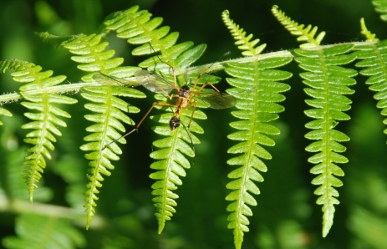 Common, above the Black Pool car park. From here we drop down into Sunnydingle. A thin dead trunk of a Silver Birch sticks 40 feet into the air above evergreen saplings. On the top sits a Willow Warbler, singing. A Common Buzzard drifts over, close to the Willow Warbler’s perch but the little songster remains stationary, although now silent. The buzzard floats up to the top of the ridge where it is joined by a second. They circle together for a while and then start to chase one another and disappear over the hill. Foxgloves are now in bloom everywhere. Grasshoppers rasp from the undergrowth. A murder of crows rises from the saplings – there may be something dead in there which had drawn them from the spot – I am not going in to find out! The Carrion Crows call noisily from nearby trees. Off up the Mary Knoll Valley. A Wren is at the top of a sapling, tail cocked, bellowing its song. Honeysuckle scent wafts from vines of the flower woven into the shrubbery at the side of the track. A Chiffchaff sings. A background
Common, above the Black Pool car park. From here we drop down into Sunnydingle. A thin dead trunk of a Silver Birch sticks 40 feet into the air above evergreen saplings. On the top sits a Willow Warbler, singing. A Common Buzzard drifts over, close to the Willow Warbler’s perch but the little songster remains stationary, although now silent. The buzzard floats up to the top of the ridge where it is joined by a second. They circle together for a while and then start to chase one another and disappear over the hill. Foxgloves are now in bloom everywhere. Grasshoppers rasp from the undergrowth. A murder of crows rises from the saplings – there may be something dead in there which had drawn them from the spot – I am not going in to find out! The Carrion Crows call noisily from nearby trees. Off up the Mary Knoll Valley. A Wren is at the top of a sapling, tail cocked, bellowing its song. Honeysuckle scent wafts from vines of the flower woven into the shrubbery at the side of the track. A Chiffchaff sings. A background 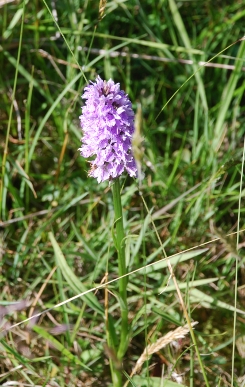 drone of insects in unceasing, overlaid by bird song. A flock of small birds is moving rapidly through the trees – too fast to get a decent view and make an identification. Certainly, there were Long-tailed and Blue Tits there, but whether there were other tits or finches I will never know as the flock has crossed the valley and is now just a memory. Speckled Wood butterflies dance together in the air, more flit to and fro. A Red Admiral sits on the path, sunning itself. An insect with a long yellow and black body, clear wings and long legs alights on Bracken frond. It has feathery antennae and is, I think, a member of the crane-fly family, maybe a female Ctenophora atrata. The track winds on before dividing, one section heading for the Vinnalls car park and the other towards Juniper Hill. A path leads off the Juniper Hill track and starts climbing onto High Vinnalls. Fortunately, as the woodland thins towards the summit, the breeze is stronger and cooling. Common Spotted Orchids stand in grassy areas between the brambles and Bracken. On top Skylarks sing and Meadow Pipits stand on low bushes watching. Willow Warbler song comes from the forest below. The sky is full of fluffy white clouds - “Simpson clouds” as certain people call them! The distant hills are hazy but
drone of insects in unceasing, overlaid by bird song. A flock of small birds is moving rapidly through the trees – too fast to get a decent view and make an identification. Certainly, there were Long-tailed and Blue Tits there, but whether there were other tits or finches I will never know as the flock has crossed the valley and is now just a memory. Speckled Wood butterflies dance together in the air, more flit to and fro. A Red Admiral sits on the path, sunning itself. An insect with a long yellow and black body, clear wings and long legs alights on Bracken frond. It has feathery antennae and is, I think, a member of the crane-fly family, maybe a female Ctenophora atrata. The track winds on before dividing, one section heading for the Vinnalls car park and the other towards Juniper Hill. A path leads off the Juniper Hill track and starts climbing onto High Vinnalls. Fortunately, as the woodland thins towards the summit, the breeze is stronger and cooling. Common Spotted Orchids stand in grassy areas between the brambles and Bracken. On top Skylarks sing and Meadow Pipits stand on low bushes watching. Willow Warbler song comes from the forest below. The sky is full of fluffy white clouds - “Simpson clouds” as certain people call them! The distant hills are hazy but 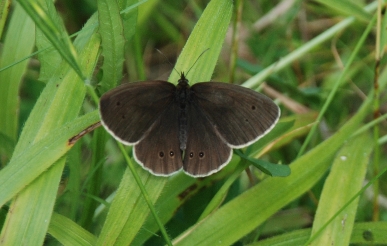 beautiful. A Whitethroat sing from a nearby Rowan sapling. I head off southwards down the track. A Blackcap sings from the trees and a Marsh Tit moves through the branches, calling explosively. A Painted Lady butterfly rests on the hot gravel of the track. A small moth flits onto a bramble; as usual, despite a fair photograph I have great difficulty in identifying it and decide it is probably one of the Carpet Moths. The path drops down through great pine plantations, the air having that syrupy, resinous scent Peter and I noticed at Heavens Gate in Somerset. The path winds around to the ponds near Hanway Common. Signs say the track is closed for forestry operations but I am not climbing back up to High Vinnalls again and the silence shows there is no felling taking place. Down the trail dark butterflies flit over the grasses – the beautiful Ringlet.
beautiful. A Whitethroat sing from a nearby Rowan sapling. I head off southwards down the track. A Blackcap sings from the trees and a Marsh Tit moves through the branches, calling explosively. A Painted Lady butterfly rests on the hot gravel of the track. A small moth flits onto a bramble; as usual, despite a fair photograph I have great difficulty in identifying it and decide it is probably one of the Carpet Moths. The path drops down through great pine plantations, the air having that syrupy, resinous scent Peter and I noticed at Heavens Gate in Somerset. The path winds around to the ponds near Hanway Common. Signs say the track is closed for forestry operations but I am not climbing back up to High Vinnalls again and the silence shows there is no felling taking place. Down the trail dark butterflies flit over the grasses – the beautiful Ringlet.
Sunday – Home – Plodding up the garden with watering-cans from the tap. We do not like using tap water, but this is now a drought, no serious rain has fallen for weeks and the butts are empty. The ground is hard and dry, everything is beginning to struggle. A row of potatoes produces 3½ kilos, not a bad crop but would have been better is they had been watered more frequently. The Broad Beans look miserable – small and covered in black fly. It has spread to one of the young Runner Bean plants. French Beans are in flower. The peas are coming to an end, it again has not been a bad crop but could have been better. The first tomatoes in the greenhouse are almost ripe and there are chillies lengthening daily. The courgettes are still struggling despite constant watering. I have obtained some rocks to place around the pond and have started filling it – more tap water!
Leominster – The Grange grows gloomy in crepuscular light where a grey hunched object is on the grass. As Maddy approaches it resolves into a Sparrowhawk that drops a dead male Blackbird as it rises from the sward. Swifts are screaming high overhead. A cooling breeze has followed a sweltering day. A small bat darts down Grange Walk between the tall buildings.
Monday – Croft – Despite the seemingly ever present sun burning from an azure sky, it is pleasantly cool in the woods. The water level in the pools is, not surprisingly, low. Bird song is constant, some full-blown 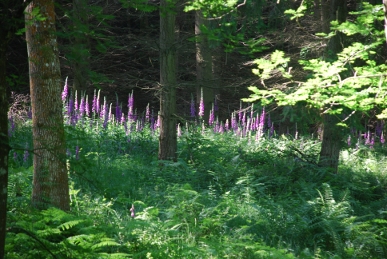 songs, others, particularly Blackbirds, just muttering. The woodland floor hosts large numbers of Foxgloves, pink spikes dominating the green undergrowth. The little rill that runs down the valley on the east edge of Bircher Common still sparkles with water despite the drought conditions. Honeysuckle climbs the old fragments of branch attached to a pine’s trunk. A Common White Wave moth,
songs, others, particularly Blackbirds, just muttering. The woodland floor hosts large numbers of Foxgloves, pink spikes dominating the green undergrowth. The little rill that runs down the valley on the east edge of Bircher Common still sparkles with water despite the drought conditions. Honeysuckle climbs the old fragments of branch attached to a pine’s trunk. A Common White Wave moth,  pure white with two faint brown lines across the wings, rests on a Bracken frond. By the time I reach the bend in the track I am sweating profusely. Insects buzz around my dripping brow. Speckled Wood and Ringlet butterflies are active. Bircher Common is dotted with spiky thistles like tower blocks on a council estate . The distant hills are shadows in the heat haze. A plaintive “A little bit of bread and no cheese” comes from the gorse which conceals the caller - a Yellowhammer. The rough meadow is speckled white with clover and occasionally the yellow of Birds Foot Trefoil or Hawksbeard and even less frequently, red of Sorrel. A cooling breeze has sprung up. Sky Larks sing high overhead. A Great Spotted Woodpecker flies up the valley to alight on a Silver Birch. A Common Buzzard drifts across the valley with barely a flicker of its wings. Back into the relative coolness and dark of the woods and back down to Fish Pool Valley.
pure white with two faint brown lines across the wings, rests on a Bracken frond. By the time I reach the bend in the track I am sweating profusely. Insects buzz around my dripping brow. Speckled Wood and Ringlet butterflies are active. Bircher Common is dotted with spiky thistles like tower blocks on a council estate . The distant hills are shadows in the heat haze. A plaintive “A little bit of bread and no cheese” comes from the gorse which conceals the caller - a Yellowhammer. The rough meadow is speckled white with clover and occasionally the yellow of Birds Foot Trefoil or Hawksbeard and even less frequently, red of Sorrel. A cooling breeze has sprung up. Sky Larks sing high overhead. A Great Spotted Woodpecker flies up the valley to alight on a Silver Birch. A Common Buzzard drifts across the valley with barely a flicker of its wings. Back into the relative coolness and dark of the woods and back down to Fish Pool Valley.
Home – In the early evening a Lesser Stag Beetle wanders across the decking by the back door. It starts to climb a post but falls off with an audible thump and lays motionless on its back. I turn it over but it stays still. However, it has gone by the morning.
Wednesday June – Credenhill – The sky is cloaked by high level cloud which is obscuring the sun. It is still warm and humid, adding to the body heat induced by the long, steady climb to the hillfort. Just before the open area created by the felling of the trees on top of the hill, a small stockade has been constructed out of logs. Outside a steel cabin stands a small, pale tan, shaggy bullock. Maddy is not impressed and it takes a combination of firm commands and cajoling 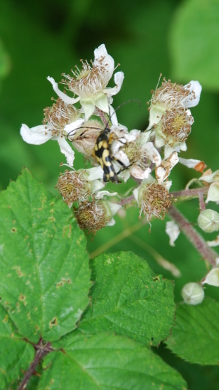 to get her past. On the edge of the hill top is a flock of sheep. The open space is covered in sedges, thistles, dock and Foxgloves. Wood Pigeons coo, Blue Tits chirrup and a Robin sings in the distance. Perforate St John’s Wort is in flower. Off along the path on top of the innermost rampart. Yews have been planted along the edge, probably sometime over 200 years ago. A lot of their lower limbs are dead and many have been trimmed. Flowers blossom along the edge of the rampart – Cinquefoil, Herb Robert, Great Mullein, Sow-Thistles, Creeping Thistle, Hawkweeds and Blackberry brambles . A Comma butterfly alights upon a Beech sapling. On the northern rampart a large Badger’s sett has been dug into the bank. Many of the tree stumps on the ramparts are sending up new shoots. Down stone slab steps some 25 feet to the north gate then back up again. Along the western edge, the last of the Wood Spurges are in flower. Bees are busy around the flowers, each seeming to be of a different species. A rather more ungainly flyer hovers in front of a bramble flower then lands. It folds its wing case to reveal a black and gold pattern – a Longhorn beetle, Strangalia maculata. Into the uncleared area of the hillfort. The Yew trees continue around the edge of the rampart although most are much younger. There are some old rotted stumps where the original Yews stood. On through the woods and down another flight of slabs at the south western gate, then back up onto the rampart. Here the form of the fort is complicated by a large area of old quarrying. Eventually the path comes to the forestry track which cuts through the rampart. A couple of maybe 100 year old Yews stand on the slope down to the track. Down the track back towards the car park. Chiffchaffs call. Near the bottom of the hill several Blackcaps are ticking loudly like pebbles being knocked together. A few moments later a Common Buzzard glides silently out of the tree beside the track.
to get her past. On the edge of the hill top is a flock of sheep. The open space is covered in sedges, thistles, dock and Foxgloves. Wood Pigeons coo, Blue Tits chirrup and a Robin sings in the distance. Perforate St John’s Wort is in flower. Off along the path on top of the innermost rampart. Yews have been planted along the edge, probably sometime over 200 years ago. A lot of their lower limbs are dead and many have been trimmed. Flowers blossom along the edge of the rampart – Cinquefoil, Herb Robert, Great Mullein, Sow-Thistles, Creeping Thistle, Hawkweeds and Blackberry brambles . A Comma butterfly alights upon a Beech sapling. On the northern rampart a large Badger’s sett has been dug into the bank. Many of the tree stumps on the ramparts are sending up new shoots. Down stone slab steps some 25 feet to the north gate then back up again. Along the western edge, the last of the Wood Spurges are in flower. Bees are busy around the flowers, each seeming to be of a different species. A rather more ungainly flyer hovers in front of a bramble flower then lands. It folds its wing case to reveal a black and gold pattern – a Longhorn beetle, Strangalia maculata. Into the uncleared area of the hillfort. The Yew trees continue around the edge of the rampart although most are much younger. There are some old rotted stumps where the original Yews stood. On through the woods and down another flight of slabs at the south western gate, then back up onto the rampart. Here the form of the fort is complicated by a large area of old quarrying. Eventually the path comes to the forestry track which cuts through the rampart. A couple of maybe 100 year old Yews stand on the slope down to the track. Down the track back towards the car park. Chiffchaffs call. Near the bottom of the hill several Blackcaps are ticking loudly like pebbles being knocked together. A few moments later a Common Buzzard glides silently out of the tree beside the track.